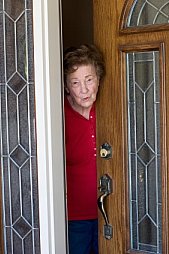About
Michael Edward Loftus, Sr.
Bio and CV
My insights into crime prevention come from a lifetime of experience starting as a child victim of domestic violence and as a juvenile delinquent growing up in Detroit with wild childhood friends, some of whom became career-criminals.
Among other things, I’ve been mob-attacked by a notorious Detroit street gang (and luckily escaped with minor injuries), another time slammed a gang leader into a wall (which luckily scared off his gang), luckily bluffed a predator in the woods reaching for a gun, luckily bluffed a robber at a gym, and luckily faced-down a menacing New York City gang brandishing box-cutters while surrounding me. (Details are below at “P.S.”) Dealing with overwhelming threats both as a child and as an adult made me familiar with the fear that women and children (or anyone) will feel when facing a sudden, overwhelming threat. See Stress Control - Overview .
Eventually, sports led me away from juvenile delinquency and a round-about path led me to teaching all types of crime prevention strategies to the general public (focusing mainly on women and children - the most vulnerable of us) and
veteran law enforcement officers at police academies. My bio is my C.V.
These pages are not the typical, simplistic safety clichés. Instead, they come from 34 years of exhaustive research as well as personally teaching thousands of women, children, and men. Actually, they taught me what they really need.
Memories
Almost my only memories from early childhood are of me hugging my mother’s legs to shield her from my violently alcoholic father’s attacks. I was his youngest of five, his “little tyke,” the apple of his eye – so he'd merely backhand me out of the way to get at her. He seemed like a ferocious giant. All I could do was run for help.
If my adult brother was home he'd beat my father unconscious in a furious fistfight; leaving all three with bloody noses and mouths and blood spattered on my toys. Other times I'd run to the neighbors to call the cops; they'd take him away in handcuffs or a straitjacket for another over-nighter in jail.
The next day he was always kind and gentle as we'd walk to the store for my candy bar and his morning half-pint of whiskey. Halfway home, he'd toss his empty bottle into an alley, I'd toss my empty candy bar wrapper and we'd laugh. It was our little ritual. By my fifth birthday he was gone.
As a 16-year-old
searching for my long-lost father, I found him covered with wine-sores, sleeping in a flophouse on Detroit’s skid row. I whispered his name and gently shook him awake, but he startled and yanked a wine bottle from under his pillow, furiously trying to bash me with it.
I held down his feeble arms while trying to explain I was his son. Soon exhausted, he gave up and offered me a swig from his half-empty bottle. I declined. He chugged the rest and passed out.
I left to get him a hamburger and nagged him awake to take a bite as I held it to his mouth. He’d barely chewed it when he passed out again. The next day the hamburger minus the one bite sat on his nightstand as he snored, clutching still another half-empty wine bottle.
I made sure he spent the rest of his days dried out in a mental asylum, eating three proper meals a day. Maybe he was better off. I wonder if he ever knew his reluctant visitor was his little tyke now grown up, and wonder if he hid behind a kind and gentle yet vacant mask.
My Uncle Tom
My only heirloom from my father, a wooden chest-of-drawers, has a bullet hole from when he shot at his brother, Tom, and missed. A second bullet went into Tom's knee and he limped with a cane for the rest of his life.
Uncle Tom once greeted me by angrily pointing his cane at me and snarling, “Your father shot me!” – though it'd happened long before I was born.
Blind to a Colossal Red Flag
I was always mystified why my mother, a gentle farm girl who’d become a schoolteacher and moved to Detroit, married into such a violent, drunken family after seeing many of their countless brawls firsthand.
She said that he, his father, and eight brothers often played poker and every hour or so a knockdown, drag-out brawl erupted between all ten – father, sons, brothers. Then, as though nothing had happened, they'd play cards again until the next fight – violence as natural as breathing. What was she thinking?
She was blind to an enormous red flag (as many battered women tend to be), somehow believing or hoping that a good, kind woman can tame a violent man. The odds on that are slim to none – most likely none.
The 800 lb. Ghost in the Room
Never mentioned by his fractured and dysfunctional family, he’d squandered his life, but in the debris I found precious lessons about victims, violence, fear, and survival. Some examples are in stress control overview.
Of course, many other kids and their mothers have had, are having, or will have it far worse. Find the light at the end of the tunnel at domestic violence.
My Fear of Fear Itself
As a 10-year-old I first saw my childhood hero one night when screaming sirens drew me to a scene outside Jo-Jo’s Bar where eight frenzied Detroit cops clubbed and kicked Lucky Barton, the neighborhood legend, into a straitjacket while he bellowed, “More! MORE!”
I longed to be even half as tough – to overcome my fear of violence that my father had instilled in me. I became addicted to testing my bravery – sometimes unable to stop laughing uproariously while in danger despite making matters worse; other times being stupidly hostile. Years later, to defeat Lucky Barton in a brawl, a motorcycle gang shot his legs out before they slowly circled him as he sat upright, taunting him in front while stabbing his back as, no surprise, he fought to the end.
As far as I know, he lost only his final battle. Though I never got anywhere near the heights of my childhood hero’s bravado, I finally realized that fine lines separate bravery, madness, and stupidity – and fear paralysis comes from not knowing just where those lines are.
Lucky Barton, whether hero, madman, or merely a spectacular fool, spurred my search for courage which now – bolstered by today’s foremost academic and military research – helps me teach innocent prey to reach the ferocious, mad-dog mindset needed to fight for their very lives if ever set upon by an evil predator – as shown throughout fighting options overview.
Especially see a victim's options: fighting for your life and stress control - optimal mindset.
At age fourteen,
I began fighting at a housing project boxing gym. Over time, it helped me outgrow the (minor-league) street gang I'd co-founded at age nine and the fast track to a life of crime, early death, or prison that too many of my childhood friends ended up on.
As we escalated to minor crimes, our paths began diverging as
differences in our innate characters began emerging. A few of my friends
didn’t care who they harmed – mugging drunken family men, stealing cars, burgling
people’s homes. Two eventually became hit men. They'd always clung to
warped values, sneering at contrary views. Others of us never harmed innocent people.
Ultimately, I learned up close the twisted morality of a criminal's mind that now – along with today's science – illuminates my lessons for innocent prey, as shown throughout criminal minds overview.
Wanting to learn to fight well
(maybe early childhood family brawls were why) and dreaming of becoming a professional boxer, I fought for eight years overall – the last three-and-a-half at Detroit’s legendary Kronk Gym. I forced myself daily to appear nonchalant while enduring the dread of battling world-class professional boxers as their spar-mate (or human punching-bag).
I was the only white there. Our father-figure was the top boxing coach in Detroit back then, the quietly dignified, wise, and kind John Brown. Race was irrelevant – all that really mattered was your heart – your desire to fight three l-o-n-g rounds per day (Kronk rounds were four minutes each).
After years of worsening chronic shoulder impingement syndrome (from grade-school, high-school, and semi-pro football, then aggravated by the demands of boxing), boxer’s neck from too many blows to the head, and a debilitating, broken L-5 vertebra (from a foolish accident) taking their toll on me as well as my quixotic dream, I quit fighting at age 22. I took the annual August rest, and somehow just never went back - procrastinating endlessly. Maybe deep inside I knew it was time to move on – while I still had a few brain cells left.
Though never achieving my goal of boxing professionally, boxing’s grueling training regimen did teach me self-discipline and a thing or two about fighting, fear control, a survival attitude, and – above all else – led me away from a wayward life and eventually to building this website.
My ridiculously reckless life
as a juvenile delinquent had put me in hospital emergency rooms maybe forty times altogether [stitches, many sprains, 28 broken bones (not counting my frequently broken nose from boxing), receiving Last Rites, etc.]. My long-suffering mother, my saving grace, had to fetch me from hospitals countless times.
My myriad injuries eventually drove me to a school affiliated with New York's Albany Medical College to become a therapist for muscular pain and dysfunction – to rehab myself from various chronic pains as well as to make a living. In the late 1980s, expecting to live a quiet life, I began working in New England clinics treating a wide variety of patients.
I pursued my own rehab exercise program at a nearby gym where I soon started a boxing program in the basement. Some students were raw beginners, some were black belt martial artists from various disciplines, and some were National Guard reservists or Army Rangers on leave.
As I taught them boxing – the king of hand strikes – I
learned the basics of their arts: grappling, joint locks, knee/foot
strikes, and weapons defense. Though formally a boxing program, none of
my students truly planned on fighting in sanctioned boxing bouts and
instead blended it into their own eclectic street-fighting survival
styles for self-defense (somewhat similar to today's Mixed Martial Arts competitions). I've since distilled and simplified it all in Fighting Options - Overview
A pain therapist teaching ways of inflicting pain really isn’t quite the paradox it may seem; defending yourself honors life – your life. It’s a matter of good versus evil – protecting innocent prey from criminal predators.
My new life
in New England soon began to change when several nurses at the troubled local hospital asked me to teach a self-defense class for them and their kids. They had little time to spare yet wanted to be safe and secure. They wanted a woman-and-kid-friendly, one-time, rape and kidnap prevention class at the hospital. Gee, is that all?
At the time, back in 1990, I’d assumed something was already being done to protect women and children but found only a hodge-podge of woefully deficient programs and books. I decided to fill that gap – a vast chasm, actually. I had no idea it would become my lifelong passion.
Modeling
my program somewhat on military express training, I began teaching fighting and
escape strategies for a child or small woman, and sent them home with my videotape on self defense and my booklet on avoiding danger in the first place (so you won't have to fight for your life). And with endless research, my little booklet grew into an exhaustively
thorough book manuscript, and strategies for avoiding danger became my primary focus (with fighting as a last resort - yet vital nonetheless).
The nurses were hungry
to learn safekeeping strategies and, as it turned out, so were plenty of other women. I began teaching classes within an 80-mile radius of my home: from many hospitals, Girl Scout and Campfire Girl troops, colleges, and senior citizen centers, to corporations and rape crisis centers (for their more severely traumatized rape survivors).
After saturating western New England and eastern upstate New York with hundreds of classes, I moved to New York City in 1995. The new direction of my life was exhausting, but what I was learning was priceless. The hopes and fears, strengths and weaknesses of an endless stream of thousands of women and children were molding my classes as well as the material that grew into my book (now all for free at Site Directory).
Their constant feedback made their needs stark and obvious in a direct, visceral way not found in any books or research. My students taught me how to teach them.
In the past 34 years,
I’ve benefited enormously from the wisdom of the experts who’ve
pioneered the frontiers of crime prevention strategies,
insights into crazed and heartless predators' minds, and therapeutic
strategies to soothe crime survivors’ haunting, crippling memories.
Throughout
that time, hoping to spare myself the ordeal of researching and writing
my own teaching materials, I kept searching for a good safety manual
for my students. But time and again, the books, programs, and websites I
found were too narrowly focused - but a few had a gem or two for me to add to my own book (now this site).
After I returned to Detroit,
the director of Michigan’s premiere Wayne County Regional Police Training Center in metro Detroit, hired me in summer 2001 to train veteran police officers from throughout Michigan on how to teach crime prevention to the general public. [I was part of the federally funded Community Oriented Policing Strategy (COPS) outreach program.] [I was also hired by a second police training center, the Crime Prevention Association of Michigan (CPAM).]
The first time a uniformed cop with badge and gun formally asked me, a former street punk, for permission to leave my 40-hour class awhile to testify in a nearby court, I thought, “Huh? He’s asking me for permission?" That moment, especially, made me realize how far I’d come.
What Cops Hate
During a break in a police academy class, one student told me of his second day as a rookie deputy sheriff in Traverse City, Michigan, fifteen years earlier:
“My sergeant drove me to a house and told me to go tell the homeowner that her son had been murdered. I said, ‘I can’t do that! You’re the sergeant, you do it!’ He said, ‘That’s right, I’m the sergeant and I’m ordering you to go tell that woman her son is dead.’ I did my duty. I stood on the porch with my hat in hand and my voice cracking as I broke the news to the woman who’d answered the door. She stared at me for the longest moment as though I were the grim reaper himself, and then collapsed, sobbing, into my arms. We cried together until a neighbor came over and I could compose myself enough to return to my sergeant waiting in the car. I couldn’t finish my shift and went home to cry all night in my wife’s arms. I almost quit the force the next day.”
As class resumed, I broached the subject to the other students and was flooded by the emotion they let loose. Cops hate delivering a death notification – some have quit the force after delivering just one.
Oftentimes partners argue or have actually gotten into fights over whose turn it is to be the grim reaper. One cop said he’d rather be in a gunfight than deliver another one.
Bottom Line: cops really do care – very much. The cops who've attended my police academy classes hope to prevent the anguish of even one more death notification – or the haunting torment suffered by crime survivors.
In the wake
of the 9-11 terrorist attacks, the COPS funding was diverted to anti-terrorism. So I helped the Michigan State Police teach access control to security personnel for hospitals, casinos, shopping malls, government agencies, and Ford Motor's executive bodyguards - former CIA, FBI, and Secret Service agents.
Once again, as in my public classes, my students feedback helped shape my book – now here in full on the Site Directory for Crime-Safety-Security.com (see why I'm putting it all online for free).
As the child is father to the man,
my tumultuous early years started me on a winding path to gather the best anti-crime advice to counter a predator’s biggest advantage: the naïveté of the prey.
Yet after 34 years I still see the endless flood of more than 4,000 victims daily in the U.S. alone – and in most cases, the crime could have been prevented. Just the littlest of tips would have spared the victim.
Here’s my summary of how to tilt the odds more in your favor:
You don’t need a bulletproof vest, a bodyguard, or to sleep with one eye open. Just learn how to be SAFE – Skeptical, Aware, Flexible, Explosive:
Skeptical of anyone trying to get near you or trying to isolate you whether you're at home or outdoors – as shown in a wolf in sheep's clothing, friendly predators, and scam-in;
Aware of traps and escape strategies – as shown in spotting danger and facing danger;
Flexible: being tricky, changing strategies as needed – as shown in victim’s options - outsmarting and verbal self defense – and if worse comes to worst:
Exploding like a mad dog to fight for your life. Stun & Run – as shown in sucker punch and self defense techniques.
In a nutshell, that is the essence of my decades searching for how to help the prey stay out of harm's way. I hope it helps you.
Michael Edward Loftus, Sr.
P.S. Some biographical anecdotes:
• Posturing > “Subway Encounter” & “Not All Threats…”
• Surviving the Worst > “Gang Attack”
• Outsmarting > “No-No's”
• Punched - absorbing and overcoming pain.
• Crime Survivors Overview > "Victim's Family and Loved Ones"
P.P.S. My thanks to...









